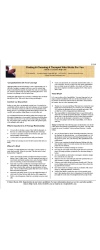In the Trumpworld, here’s how popular becomes “true”
In this election year, Trump does a number of things to try to influence voters’ beliefs and actions. Psychology can help us both understand and protect ourselves from being unduly influenced by “tricks” that take advantage of how our brains process information. Specifically, Trump works very hard to tell voters how “popular” he is, and who supports him trying to get people to conclude that if he’s popular, then he must be right, which is clearly fallacious. Also his use of repetition is another “trick”, because we have a tendency to believe what is repeated to us AND occurs frequently around us.
Below is a discussion of the psychological underpinnings of this: social facilitation and disinhibition.
Albert Bandura, a pioneer in Psychology who is almost never given his deserved place as a breakthrough Psychology researcher, began investigating how we learn from others via observation. He suggested that we are wired to observe others, and learn by what we see them do, and the consequences that results to the people we observe.
He founded an approach, labelled Social Learning Theory (Observational Learning) that started the scientific move away from Radical Behaviorism (Skinner) and towards studying cognition, too.
His work, supported by his own research, and the work of others who followed, supported his theories, if not in all particulars. We learn a lot by watching. In fact, it’s possible to learn even motor skills by simply watching, without actual practice in the “real world”.
An Example: Social Disinhibition
One of his interests involved the degree to which observers of violence in film and television increased their levels of aggression. You are probably familiar with the general debate because its quite relevant to whether children, in particular, but also adults, are negatively affected by the violence depicted in our media.
Studies are still looking at and replicating earlier experiments, but the upshot is that people ARE affected negatively, at least in experimental laboratory based situations.
In order to examine audience effects when viewing filmed violence, male subjects watched an aggressive or a neutral movie either alone, accompanied by a passive confederate (i.e. mere presence of a co-spectator), or an active one (i.e. reacting to the movie). The subsequent behavioural measures of subjects’ aggression were collected via a modified aggression apparatus. The usual instigation effect of filmed violence was found. Furthermore, the type of audience also influenced aggression: subjects accompanied by an active confederate during the violent movie displayed their aggressive behaviour most. These findings stress the importance of the social context when filmed violence is viewed. The results are discussed in terms of social facilitation and disinhibition effects. It is suggested that an active audience may promote a reduction of restraints against aggressing by showing the subject that aggression is permissible.
To put this into a less jargony context, here’s what it means:
- Observing violent instances portrayed in media tends to increase aggression in the observers, as measured in the lab setting. This is an extremely robust finding across many of these experiments.
- People who view violence WITH someone else, exhibited more aggression than those who viewed alone.
In other words, people learn from others, and modify their behavior if others are present. The particular effect in this experiment is called “social disinhibition” which means that by watching others, we tend to do things they do that we would not normally do.
A good example of this is crossing against a red light. If you are part of a group of people, strangers in fact, on a corner, and the light is red with everyone stopped, if any ONE person crosses against the light, more will follow. Then more. Then almost everyone goes.
So What, You Ask?
Moving away from the aggression, media and violence debate, which we’ll leave to those interested in that, the findings that we are influenced by the behavior of others, influenced to emulate, follow or copy can be applied to many everyday life issues and “brain errors”.
The Scariest One — Popularity = Truth
Because we learn so much through observation, we have a tendency to believe in that which others believe in. The more we see people expressing a particular view, the more likely we are to believe that it is true. We tend to do what others do.
The problem is that as a result, you probably believe in things that you’ve seen other people espouse, simply because you’ve seen the same thing said by different people.
That isn’t a problem if there is strong evidence that can be reviewed, but it has become much more of a problem now that we are bombarded by people’s thoughts in social media. Our world has become so complex, and there’s so much information to investigate, that we usually don’t investigate, and we often cut corners, and just accept what we see tweeted, updated, talked about, etc.
That ties in with our fundamental principle of the brain as an information reduction system. Both observational learning, and forming beliefs based on the opinons of others tie in to reducing the load on our brains. We don’t have to spend a year gathering data about an issue — most of us don’t do that because if we did that for everything we’d never sleep, and never DO anything else.
We, as in ALL of us, form opinions based on the opinions of others. Often with no facts needed, no data.
The result is that we also repeat those same opinions, perhaps modified, and accept them as fact, even passing them on, contributing to a bigger swell of people accepting the beliefs.
The Social Media Flood — A Case In Point
Social media; Twitter, Facebook, LinkedIn, and blogs both serve to affect the way we think without any base in fact, AND the huge growth of social media has resulted in discussions about social media that are creating additional buzz, and thus to people joining. Seeing and hearing about this social media platform and that social media platform, and the number of people who have jumped on the bandwagon encourages others to do so.
The problem is that the masses of people using social media has resulted in the repetition of opinions and positions that simply have no supporting data.
Coupled with the fact that few people want to dispute what 700 million people believe, and we come to believe things that are not true, partly true or otherwise misleading.
Here’s an example.
Twitter is hugely popular and is a great tool for business. Not only is this not true, but there’s significant data to support the idea that the HUGE majority of accounts on Twitter are inactive, never used, or used so infrequently that there’s really nobody “there”.
According to a study by RJMetrics, Twitter’s rate of churn isn’t 60% as Nielsen found in April, it’s 80%+, with only 17% of Twitter accounts sending a single tweet over the past month. Here’s a story from Computerworld explaining some of the numbers, from 2010.
A number of other studies have found simliar things. It may be true that the committed users are heavy users, and loud users, but they consist of such a small minority of the population, and you hear them so often, that you believe Twitter is a much more popular place and a much more valuable place that it really is.
So, why do you believe Twitter is so popular? Because that’s what everyone is talking about, but everyone is talking about the wrong things, and the wrong evidence. A good example of social learning on your part, and how we sacrifice truth, and eschew seeking out good answers, for convenience, and to allow our brains to rest.
For many people it won’t matter. You’ll try Twitter. You may like it. Or not, and if not, like the other millions of people who don’t like it, you will leave silently and invisibly and find something more to your liking.
However, when it comes to making decisions that are important — business decisions, for example, we see huge challenges. By being affected by what other people say, and without seeking out proper independent validation, businesses are squandering huge amounts of money and human resources on the basis of what is flat out wrong.
That affects not only the viability of these businesses, but the lives of their employees, suppliers and customers, if the business becomes no longer sustainable because of the losses incurred.
That IS no joke.
Awareness is The Counter-Weapon
Fortunately, we can become more aware of our propensity to accept that which we see other people accepting, and start asking ourselves questions to push ourselves to become more rational, logical and data based. Here are the kinds of questions we need to ask ourselves, and others from whom we learn.
What actual evidence is there that disconfirms my/their belief? Rather than starting out by trying to validate the things to agree with, start the other way round.
Ask, what assumptions does this belief or “fact” require? For example, I’ve seen thousands of messages stating that businesses must serve customers via social media. But what does that assume if it’s true? The answer is: It assumes that customers will care more about how they are served (via phone, email, Twitter, Facebook, etc) than the quality of the service they receive.
Can that really be true? For a few people, maybe, but certainly not for most average customers who couldn’t give a rat’s ass about that. They want no hassle service, fast, whether it comes in a tweet, an email or a phone call.
If the underlying, and unexpressed assumptions are wrong, so is the opinion, belief or fact.
Am I swayed because I hear the same thing repeated over and over again by so many people? Only you can answer that, of course.
Where can I find information that comes from unbiased people who have qualifications and a strong track record of bucking the popularity trend? The answer is that you have to look for more “academic” sources, studies and research conducted and published in peer reviewed type journals. In other words, you may have to validate things OFF the Internet.
That’s because the Internet, as a mass medium, tends to repeat what IS popular, making it appear “true”.
Before We Go
Mercifully, after a while, popularity tends to have less importance as we gather more and more information and more and more data. That’s one reason why fads in business come and go. There’s the bandwagon effect that pushed jumping on, a period of growth and buzz, and then as data rolls in, or as experience increases, people realize the promise of the fad is never realized.
In the case of social media, we’re getting closer to that point, as there are now more voices questioning assumptions, and more data becoming available. Business is often the engine that both contributes to fads and to make them go poof, because to invest in a useless fad could mean business failure.
I’d be interested in whether you have other ways to fight the brain’s tendency to be influenced by what’s popular, and what other people think, when there is ambiguity, and minimal “evidence”.
How do you “check” that you believe?






